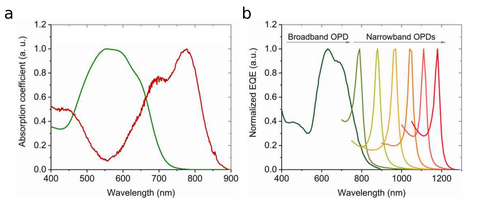Broadband-Broadband / Broadband-Narrowband Stacked Dual-Wavelength Organic Photodetectors
As one of the most ubiquitous technologies, photodetectors are playing a pivotal role in industrial automatization, medical monitoring, agriculture and smart devices for consumer applications. In the past decade, organic photodetectors (OPDs) have drawn tremendous attention because of the endowed advanced properties such as lightweight, flexibility, low-cost production, large-area scalability, biocompatibility. [1]
A key feature, required for OPDs to be employed for novel applications, is the capability of sensing dual wavelengths with a single detecting window. The dual-band OPDs can be constructed by stacking two OPDs on top of each other. The stacked OPDs can measure independently of the light intensity and unaffected by ambient noise like dust, smoke or steam. Hereby, such OPDs can pave a way for highly integrated and irradiance independent advanced sensing systems.
In organic electronics, stacked broadband OPDs can be realized by employing organic materials, which have complementary absorption as shown in Figure 1a. The combination of these two material systems covers the spectral range from 400 nm to 900 nm, making them good candidates to realize dual-broadband OPDs.
Furthermore, the previously published micro-cavity enhanced OPDs [2] suffer from parasitic photoresponse out of their intended detection window, being mainly induced by higher order resonances or intrinsic above-gap absorption. To overcome this issue, traditionally, a bandpass filter or a layer of intrinsic photo-absorbing material is integrated in front of the OPD, increasing its complexity. As shown in Figure 1b, this problem can be elegantly solved by integrating a broadband, non-cavity OPD in front of a cavity-induced OPD, both of them employing the same photo-absorbing materials. The broadband sub-cell has a detection window covering the visible range; simultaneously, the narrowband sub-cell gives broad tunable photoresponse in the NIR regime. Both sub-cells are expected to have no side effect to each other.
This master thesis project will focus on realizing the mentioned broadband-broadband and/or broadband-narrowband OPDs by selecting suitable photoabsorbing material systems and designing the desired device architecture. Furthermore, the project also requires a combination of optical modeling and device characterization. The stacked devices will be characterized by measurements of the external quantum efficiency, current-voltage curves in the dark and under illumination, response speed and noise.

(a) Absorption coefficient of two organic bulk heterojunction blends, exhibiting complementary absorption. (b) Simulated, normalized EQE curves of a broadband OPD and multiple narrowband OPDs illustrating the concept of broadband/narrowband stacked dual-w
[1] Y. Wang et al. Materials Horizons 9, 220-251 (2022) link: https://pubs.rsc.org/en/content/articlehtml/2022/mh/d1mh01215k
[2] [B. Siegmund et al. Nature Communication 8, 15421 (2017) link: https://www.nature.com/articles/ncomms15421
